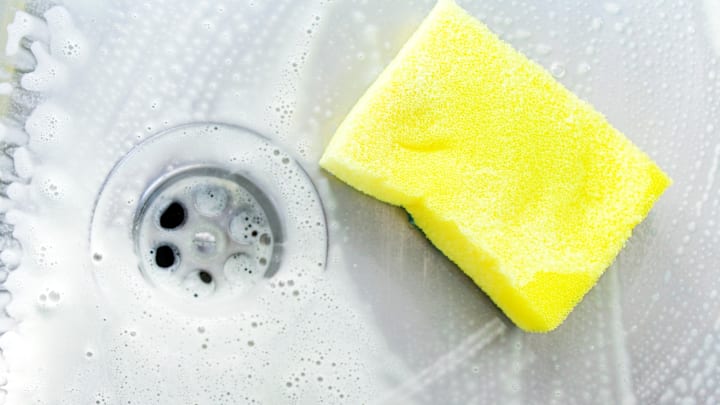There are plenty of areas you’re probably forgetting to clean, and your kitchen sink might be one of them. Luckily, the process hardly takes any time and only requires a sink strainer, dish soap, a sponge or brush, and bleach or a bleach-based cleaner.
Why You Should Clean Your Kitchen Sink More Often

Wiping down the counter or stove is usually second nature to most home cooks. Scrubbing the sink, however, can get overlooked.
But you really shouldn’t skip giving your sink a good cleaning: it’s may be harboring tons of bacteria that can cause foodborne illnesses. Foods like uncooked meat, raw eggs, and fresh fruits and veggies can all transmit bacteria that can make a person sick. And even though you obviously aren’t cooking such things in the sink, just touching the area after handling those foods can spell trouble.
It’s way too easy for cross-contamination to occur, and simply spraying the basin with water isn’t enough to keep things fully sanitary; this is why the USDA recommends giving your kitchen sink a good cleaning after using it to wash or prepare food.
You May Also Like:
- 7 Tips for Deep Cleaning Your Home
- Why You Should Never Let Dirty Dishes Soak in the Sink
- You’re Probably Forgetting to Clean the Grossest Part of Your Refrigerator
How to Clean and Sanitize Your Kitchen Sink

Cleaning the sink may seem like an arduous chore, but it isn’t all that difficult (or time-consuming). Here’s how to ensure it stays as sanitary as possible:
- Remove everything in and around the sink.
- If there are food bits in the sink and you have a garbage disposal, turn on the water to send the food down the drain and keep the disposal running for 20–30 seconds. (If you don’t have a disposal, you’ll need to use a sink strainer to catch all the bits and put them in the trash.)
- Most multi-surface cleaners can clean sinks. Spray the product all over the area, follow the instructions on the bottle, then wipe the sink down with a clean sponge or rag. You can put a little dish soap on a brush or sponge and scrub the sink to remove any stubborn stains.
Once you’ve given your sink a good preliminary cleaning, you can move on to sanitizing it to remove any lingering bacteria. It's essential to thoroughly rinse out the sink before doing so—combining bleach and other cleaners, like those with ammonia, can cause a dangerous chemical reaction.
The USDA recommends a homemade sanitizer (one tablespoon of liquid chlorine bleach per gallon of water) for killing bacteria in the sink. But eliminating viruses, on the other hand, requires more bleach: five tablespoons per gallon of water, per the CDC. (A commercial spray with bleach will also work. In this case, you’ll want to spray the sink, faucets, and handles with the product.)
